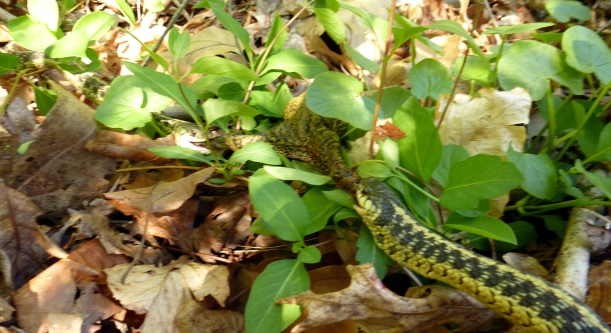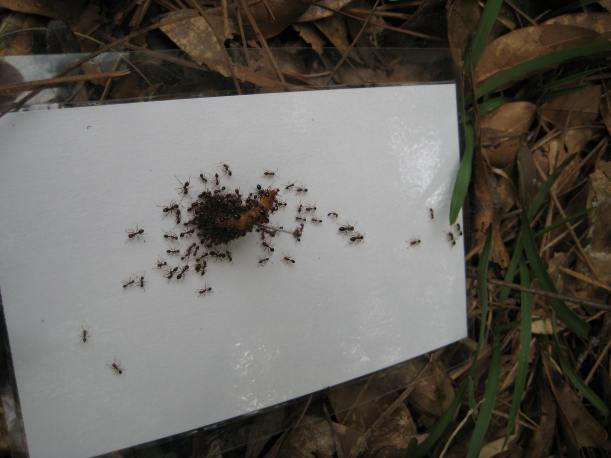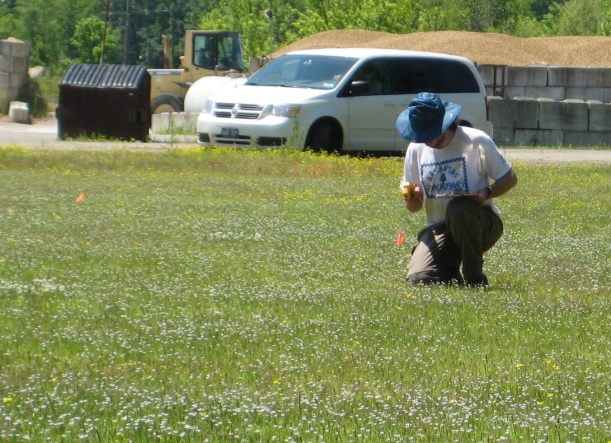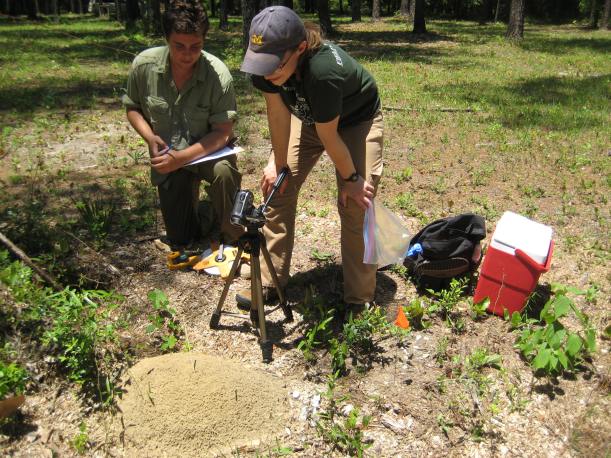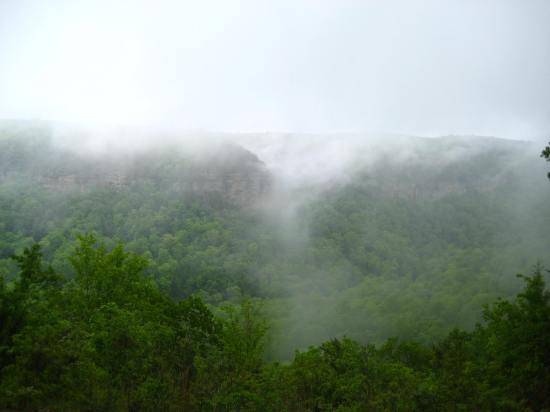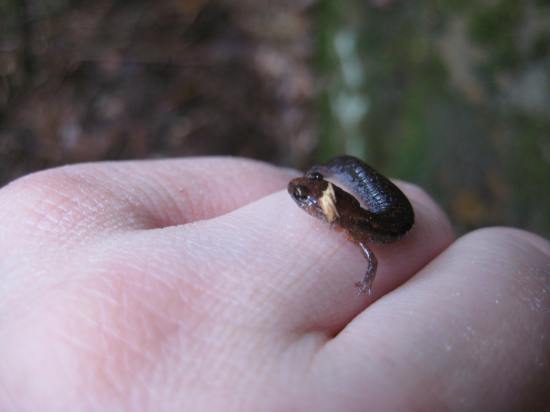On April 28th, at long last, the Langkilde Lab embarked on its oft-postponed Lab Field Trip. Most of the lab convened at 9 AM in the Beaver Stadium parking lot on a bright Sunday morning to pile into three station wagons and head North in search of fossils and hellbenders (living fossils!).
Our first destination was the Red Hill Site, a road cut near Hyner, PA that is administered by the Academy of Natural Sciences. The Red Hill Site contains fossils from the Devonian period, the Age of Fishes. Previous finds at the Red Hill Site include lots of plant materials, but, more interestingly (to our lab at least), early tetrapods including some of those described in work by Neil Shubin and others. Any fossils from early tetrapods or Devonian fish were on our wishlist that morning, and the Red Hill did not disappoint!
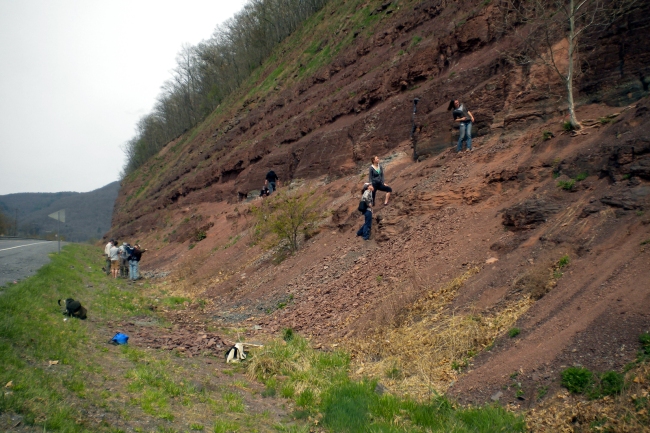
The Langkilde Lab exploring the Red Hill Site
Soon after we had parked on the side of the road and hiked up to the cut, Doug Rowe, the manager of the site, pulled up and gave us great info on where to start our search (we had called ahead to ask permission to check out the site, as should anyone who wants to check it out, as it is an active research site!). Everyone dove right in to the talus slope, using fingers and the occasional hammer, to pull apart the thin layers of sandstone and mudstone and peek between them to see if any fossils were present. Doug helped ID our finds and showed the amazing ability to identify rocks that were already laying around that contained interesting fossils. We found lots of plant material including charcoal from ancient forest fires that left our fingers black. After searching for a while, we did turn up some very cool finds: Renee spotted a fish spine, several folks found fossilized fish scales, and Sean and I both uncovered ancient fish teeth. Even Darren and baby Nora (Brad’s F1) got into the act, enjoying the beautiful weather and abundant rocks for collecting.

Brad, a slightly bemused Nora, and Renee hunt along the Red Hill slope

Doug Rowe and Jenny discuss the finer points of fossiling.

Sean shows off his long-sought find: a Eusthenopteron tooth!
Fossil-hunting was hard work, so we headed up to Hyner View State Park, for a well-earned lunch break. We wound our way carefully up the narrow route onto the bluffs as it twisted and turned like a hellbender in a stream. Once on top, we were treated to a gorgeous, panoramic view of the valley of both the western branch of the Susquehanna River below, as well as a finely-sculpted, ripple-muscled specimen of an axe-wielding logger.

The panoramic view from the Hyner Overlook.
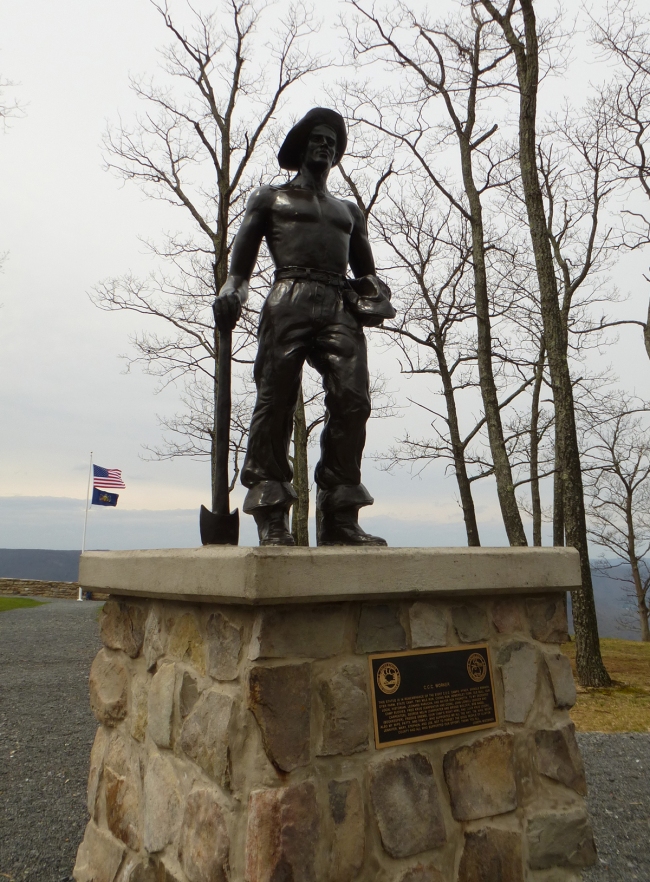
Loggers are incredibly attractive.
Lunch was a relatively short affair, as clouds were rolling in, and the lab was eager to start questing for hellbenders before any rain began. Hellbenders have one of the most dramatic appearances and sweet common names of all North American amphibians. They are found under large rocks in cold mountain streams throughout the Eastern U.S., although their populations have been declining across this range in recent decades due to pollution and development near streams. Hellbenders are the only representative of the family Cryptobranchidae in North America, and are known to reach over 2 ft. in length, the largest (by mass, anyways) salamander in the western hemisphere. Their common name seems to derive from their characteristic movement in streams, as noted by Barton (1814):
“I must not omit to mention a very singular name by which this animal is, known, in some parts of the United-States. By the negroes in the western parts of Virginia, on the waters of Holsten, where it is common, the reptile is often called Hell-Bender, by reason of its slow twisted motions, when moving in the waters, which the slaves compare to the tortuous pangs of the damned in hell. Is it beneath the dignity of natural history to notice such vulgar names, when they serve to throw any light upon the habits or economy of an animal? And does not the moralist perceive, that there is something melancholy and distressing in the condition and reflections of those who impose such names?”
While these “snot otters” are rarely seen moving on the streambed, we aimed to find one via determined searching underneath large, flat rocks in Kettle Creek, at a site Sean led us to where he had been able to dredge up hellbenders before. Upon arrival, Sean asked for volunteers, with Jason and Jennie, the two lab interns, and me answering the call. Hunting for hellbenders involved splashing into the just-above-icy-cold creek and searching for likely rocks.

Chris, Sean, Jennie, and Jason hellbender for all they’re worth.
Sean and I would reach down into the swirling water, search for a strong handhold along the slippery, algafied edges of the stones, and heave up on the count of 3. Jason and Jennie, standing with dipnets just downstream of the lifted rock, swept their hands underneath the rock, attempting to drive any potential hellbenders into the waiting nets. Our team worked our way through a 200 meter section of the stream, but found only one hellbender, which managed to elude our carefully placed nets. Argh! After an hour in the creek, Sean, Jason, Jennie, and I were thoroughly chilled, but had had an awesome time in spite of it all. Fortunately for us, Darren saved the afternoon by catching a crayfish and looking incredibly good doing it. The whole group packed by into our Subaru Forester Armada for the long drive home, discussing when we would make another attempt to capture the elusive hellbender.

Darren proudly displaying his crayfish find!
